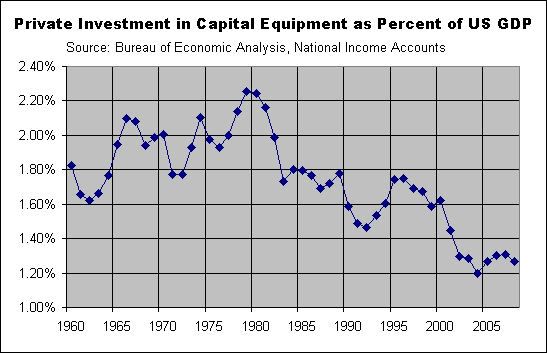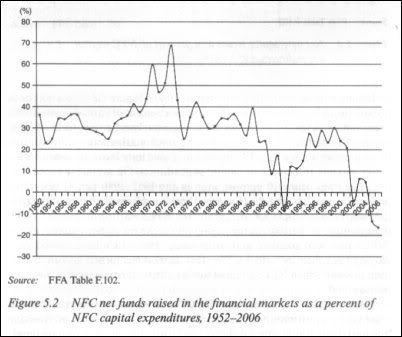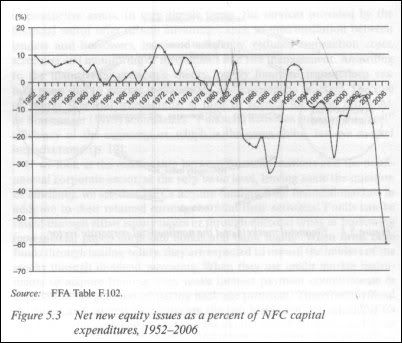Suggestions to solve the financial crises by basically shutting down most of Wall Street are always shouted down by howls of “How are companies going to raise money?” or “How are people going to invest in companies?”
Well, take a good, long look at this graph, which shows the percentage of capital expenditures by U.S. non-financial companies that was raised in U.S. financial markets from 1952 to 2006.
Wall Street simply is not doing what most people think it’s doing. Nor what most people think it should be doing. Wall Street is not even doing what it says it is doing. Wall Street is pushing a big myth that its services are essential to the functioning of the rest of the economy. But the truth is, as this graph shows, Wall Street does not -- and has not for a very long time -- serve the function of allocating credit in the economy.
This graph is from page 85 of a book by Roosevelt University economics professor Ozgur Orhangazi, entitled Financialization and the US Economy, published in May 2008.
As Orhangazi notes, “The largest and most important use of funds by the NFCs is the expenditures made to acquire capital goods for productive purposes.” (I disagree; the most important, but certainly not the largest, is spending on research and development. Capital expenditures is the second most important use of funds by NFCs.) Wikipedia has a useful definition of capital goods:
Individuals, organizations and governments use capital goods in the production of other goods or commodities. Capital goods include factories, machinery, tools, equipment, and various buildings which are used to produce other products for consumption. Capital goods, then, are products which are not produced for immediate consumption; rather, they are objects that are used to produce other goods and services. These types of goods are important economic factors because they are key to developing a positive return from manufacturing other products and commodities.
Also interesting is the graph on the next page of Orhangazi’s book, which shows that since 1984, new equity issues have been less than capital expenditures by U.S. non-financial companies, except for the three years of 1991 to 1993. In other words, non-financial companies do NOT use the stock market to raise funds for capital improvement programs.
In fact, Orhangazi notes,
Figure 5.3 shows net funds raised through equity issuance, this time as a percent of capital expenditures (recall that in Figure 2.14 we saw NFC stock buybacks as a percent of NFC / gross value added). It is evident that the stock market has not historically been a major source of NFC funds. On a quarterly basis, its contribution never exceeds 18 percent of capital expenditures. On average its contribution has been below 10 percent, even in the 1952-1980 period before (the increase in stock buybacks. However, there is a dramatic change in the relationship between the stock market and the NFCs starting in the early 1980s. Except for brief periods, in the post-1980 era the net equity issuance of the NFCs has been negative and often large. The NFCs have indeed been buying back their own stocks. The stock market has turned into an institution through which NFCs channel funds to financial markets, not the other way around.
What about the bond market? According to Orhangazi, from 1952 to 1980, NFCs obtained eight to 25 percent of their capital expenditures from the bond market. After 1980, when the “Reagan Revolution” allowed Wall Street to regain the control over the rest of the economy it had lost in the New Deal, NFCs usually obtained around a quarter to a third of their capital expenditures from the bond market, with the high reached in 2001 of 45 percent. But the largest source of funding for NFC capital expenditures had been far and away internal funds.
But isn’t it a good thing that non-financial companies mostly use their own funds for capital expenditures? First of all, remember that what we’re trying to do here is debunk the myth perpetrated by Wall Street that the financial markets are of crucial importance to the rest of the economy.
Second, the fact that the financial markets contribute so little to the most crucial operations of non-financial companies is just the beginning of the story. The financialization of the economy has had severe effects on the goals and objectives of NFCs, not just their operations and capital expenditures. What has really happened is that while the size of financial markets and types of financial instruments and transactions have increased, non-financial companies have been forced to abandon the long-term planning and goals of industrial capitalism, and instead adopt the short-term perspective and “quick buck” goals of the financial markets. This short paper by Orhangazi, Financialization and Capital Accumulation in the Non-Financial Corporate Sector: A Theoretical and Empirical Investigation of the U.S. Economy: 1973-2003 an October 2007 Workingpaper of the Political Economy Research Institute, University of Massachusetts, Amherst, contains many of the main points of the book. Beginning on page 6, Orhangazi explains how and why real investment, such as capital goods expenditures, have suffered in the “financialization era” from Reagan until today.
There are two main channels through which financialization could hamper real investment. First, increased investment in financial assets can have a ‘crowding out’ effect on real investment. Total funds available to a firm can either be invested in real assets or used to acquire financial assets. When profit opportunities in financial markets are better than those in product markets, this creates an incentive to invest more in financial assets and less in real assets. There are two cases to consider. First, if we assume that external funds are limited because of quantitative constraints, because additional funds are only available at a higher cost, or because internal funds are ‘safer’ than external financing for the firm, then investing more in financial assets crowds out investment in real capital. Second, the pressure on firm management to increase returns in the short-run can force them to choose financial investments, which provide more rapid returns, as opposed to real investments, which provide returns in the medium to long-run. . . .
A second channel through which financialization could undermine real investment is by means of pressure on NFCs to increase payments to financial markets in the form of dividends and stock buybacks by the firm.8 Of course, if the evolution of financial markets and practices in the era of financialization leads to greater debt burdens on NFCs, interest payments will rise as well. The increase in the percent of managerial compensation based on stock options has increased NFC managers’ incentive to keep stock prices high in the short-run by paying high dividends and undertaking large stock buybacks. Simultaneously, the rise of institutional investors, who demand constantly rising stock prices, as well as the aftermath of the hostile takeover movement have pressured NFC managers to raise the payout ratio. NFC managers are thus motivated by both personal interest and financial market pressure to meet stockholders’ expectations of higher payouts via dividends and stock buybacks (a shift in incentives) in the short-run. Both the NFC objective function and its constraint set have changed. As a result, the percent of internal funds paid to financial markets each year has risen dramatically. This creates three distinct restraints on real investment. First, if internal funds are cheaper or safer than external financing, rising financial payments would decrease the funds available to finance real investment by reducing internal funds. Second, the time-horizon of NFC management has dramatically shortened, hampering the funding of long-run investment projects, including research and development. Third, since the firm management does not know how much it will cost to re-acquire the financial capital it pays back to financial markets each year (i.e. it has no idea what the cost of financing for ongoing long-term projects will be next year), uncertainty rises, making some projects with attractive expected gross long-term returns too risky to undertake.
And there is no mistaking what the results have been.

The fundamental problem is the big players on Wall Street have misused the credit mechanism of the economy for their own private gains through the bloating of debt and speculation, at the expense of actually allocating and supplying capital to the real economy. The dollar volume of financial trading has increased nearly forty-fold since the 1960s, but almost none of that trading is of any use to the real economy. Even now, after the collapse of September 2008, big Wall Street firms like are still making most of their money by trading for their own account. Last month, Time.com reported that Goldman Sachs
made nearly $2 billion in the first three months of this year alone. But some analysts say Goldman, which received $10 billion from the government through the Troubled Asset Relief Program, is generating most of those profits by making risky bets on interest rates and other fluctuations in the financial markets with money it has received from the government.
Anyone who believes that saving the financial system is the way to save the economy, just does not know what the financial system is really all about.
But what about those people who want to save the financial system, because they do know what the financial system is really all about? They’re the ones winning the political fight, so far.



Comments
wow, just wow
This is an exceptional post Tony. You are showing a fundamental assumption flaw as well as how the real economy, the one that keeps people employed, makes things, gives real services has been in a downward slope for years.
Great job!
Question
Does the studies really take into effect the impact of private equity firms? I have friends who own companies, who instead of selling debt or even float to the public simply go to private equity firms or other institutionals. Organic growth will many times meet the need of capital expenditures. As for shutting down Wall Street, well I'm not sure about that.
Something else that just occured to me. Looking at those charts (particularly that last one), this info serves as a derivative to the de-industrialization of the nation. As we lose companies that make things, or at least they move offshore, there will be less and less need to issue new debentures for purchasing things like new factories and such.
A capitalist economy with less capital intensity
That last chart, showing Private Investment in Capital Equipment as a Percent of GDP, shows the great contradiction of the past half century: a capitalist economy with less capital intensity.
But what is cause and effect? Is there less capital intensity because of de-industrialization? Or is financialization driving de-industrialization? The market ideologues argue that de-industrialization is mostly the natural result of market forces at work: American labor is too expensive, blah, blah.
I think the truth is much closer to financialization being the cause: the great conservative political fight for over half a century has been to roll back the financial regulations that were imposed in the New Deal. The unstated goal was to allow concentrations of wealth (i.e., the Mellon family, or the Koch family, or the Rockefeller Foundation, etc.) to once again control the economy. This fight was cloaked in the argument of "unleashing the creative potential" of the financial markets, but what it really did was allow usury, speculation, and rent to become the most "profitable" types of economic activity.
Regarding the first point, are private equity firms properly considered part of "Wall Street"? My hunch at this point is that much of the private equity financing comes from Silicon Valley and other new wealth concentrations created by the computer and internet revolutions.
As for closing down Wall Street - well, that's exactly the point of this blog: to show that actually, of the over three trillion dollars traded in U.S. financial markets each day, very little of it is directed to the primary function of allocating capital to people and companies that will use it productively to create real wealth. What we as a society must do is devise and implement new policies that make it once again profitable to engage in real economic activity, while discouraging and penalizing usury, speculation, and rent. Those people and institutions on Wall Street that can accept and adjust to such a new policy regime will survive. Those that can't, won't - and should actually be hurried to their graves. Because the basic moral question of all economic activity comes down to the survival of the human species. The environmental problems we face should make that moral question starkly clear. What the conservatives, rentiers, speculators and usurers are demanding is nothing less than the "right" to act immorally, and to "profit" from that immorality.
This moral question is especially clear when considering "there will be less and less need to issue new debentures for purchasing things like new factories and such." Half the world's population lacks access to what we consider basic infrastructure: drinking water, sewage, electricity, mass transit, medical care:
There is no one I know of in the world looking at the physical bill of materials to actually meet the world's needs, but I suspect, based on what I was researching and writing about 20 years ago, that it is still the case that there is not enough steel production capacity, valve production capacity, skilled manpower, etc., to get the jobs done that really need to be done. Most recently, I calculated that just to build a real rail mass transit system in the U.S. would require the entirety of two and oen half years of domestic steel production.
Another question
But does economic prosperity, or allow me to be more specific, does financial allocation be mandated to be invested in "real" capital. What is the true definition of real capital? Is it tangible items like factories and such?
The reason why I'm bringing this up, is reading the piece again, it occured to me that it may not take into account the rise of non-tangible assets. Inttellectual property, software, methods, financial transaction vehicles (even those infamous credit default swaps).
Sooo many studies on PE
Beginning with the GAO, and along with Wharton, there have been an almost infinite amount of studies on the negative, destructive impact of private equity firms on the economy in general, and American corporations, in particular. And all those collateralized fund obligations (CFOs) and collateralized (commercial) loan obligations (CLOs) coming due - and about to default - will most probably usher in the next meltdown.
The classic case is the Blackstone Group and TravelPort, but NJR Nabisco, and so many others, represent the continuing down side of the peddling of "junk paper."
Short Term thinking
much like our Congress, has created this debacle. What's the profits for the next quarter? preparing for the next election? Does anybody think long term anymore?
Somehow this idea of paying CEO's with company stock has to end. Yes, its cheaper for the company but when the guy, looking at his bonus in company stock, is making decisions for direction .... you don't think there is a conflict of interest???
Running a corporation based on its stock price has created one problem after the next. (search for cheaper labor, labor reductions, over priced stock, piss poor decisions and short term thinking, reduction in money to grow the business, huge payouts to CEO's that have fucked the company but increased share price). Then there was that back dating share payouts.
I just cheated - EP admin
In case you are wondering why you're now at the top of the front page.
I changed the timestamp because I thought your post deserves way more reads than just the weekly collection of economic funnies that I post every Sunday, so I wanted yours first.
I want to change this in the upgrade, to have the reordering of the front page not just on time of publication but also a mix of time as well as votes but for now, front page is just based on time (and the vote is static, it's either you're on the front page or off).
Thanks for providing more
evidence that we don't need financial conglomerates. I am glad that a professor from a fine institution like Roosevelt University was cited.
Financial conglomerates failed in many regards but were rewarded for their failures. They failed to manage risk and the failed to help small businesses (especially with their mortgage craze). Professor Edmund Phelps has suggested that financial conglomerates certainly have not fostered "economic dynamism and inclusion". I agree.
So what purpose do they serve that is so worthy of trillions of dollars?
RebelCapitalist.com - Financial Information for the Rest of Us.
WALL STREET is parasitic on
WALL STREET is parasitic on the US economy.. with the exception of the initial IPO, which in recent years has been often found to be little other than a scam in and of itself..
(sorry, that business model projection didnt pan out.. my LLC is bankrupt, your IPO money is ahem.. well..''gone'', OH, and our former board of directors is off to Bermuda on my personal Yacht, where we will do some 'banking' (well, depositing) while enjoy the scenery..
With the exception of the random legit IPO the markets exists to lavish stolen income on manipulators, schemers, and fraudsters who did nothing to create anything of value, who bring nothing of value to the table but a lack of character and a willingness to benefit without any labor on their part, no matter its cost to the nation as a whole.
Basically the market is means of minimizing the legitimate labor of others, and maximizing the non-existant conribution of its parasitical cabal.